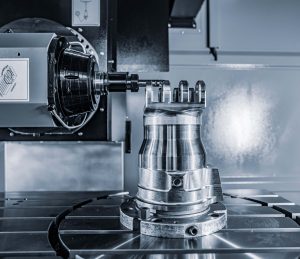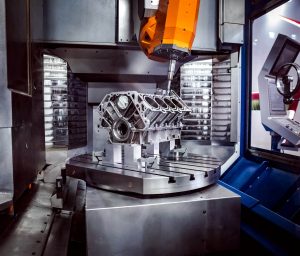This guide highlights five practical trends—what they are, why they matter for precision and compliance, and how to translate them into lead-time and quality gains on your next RFQ.
Trend 1 — AI-Assisted Quality Moves to the Plant Floor
AI in fabrication has moved beyond buzzwords. On today’s floor, machine vision models spot surface defects and dimensional issues in milliseconds, while anomaly detection flags out-of-control toolpaths or weld signatures before they create scrap. Leading OEM trade outlets report AI rising from “futuristic concept” to a competitive necessity, with investment momentum through the decade. OEM Magazine
Where AI adds value right now
- Vision inspection: Classify scratches, pits, and incomplete features in real time, reducing manual checks.

- Process monitoring: Detect drift in laser parameters, spindle load, or bead geometry to prevent rework.
- SPC assist: Automatically group lots and trigger containment when variation spikes.
What to pilot this quarter
- Start with one high-defect, high-volume feature family and build a labelled image set.
- Tie pass/fail to your NCR workflow so findings drive action, not just dashboards.
- Measure success on false rejects, false accepts, and minutes to disposition, not demo accuracy.
For a deeper view of how AI is reshaping OEM manufacturing, see OEM Magazine’s feature “Revolutionizing OEM Manufacturing with AI,” which synthesises applications from vision to predictive maintenance. OEM Magazine
Trend 2 — Build to Print Goes Fully Digital (The “Digital Thread”)
Build-to-print succeeds when the right data reaches the right station at the right moment—unchanged. Paper travellers and ad-hoc PDFs invite transcription errors, missed revisions, and tolerance misinterpretation. The digital thread concept—digital continuity from design through fabrication, inspection, and delivery—reduces those handoff risks and shortens the path to PPAP/FAI. National metrology research details how digital-thread methods and standards speed design-to-production and improve information traceability across engineering, manufacturing, and quality. NIST+1
Why data fidelity matters
- Single source of truth: CAD + PMI + approved process notes flow together, minimising ambiguity.
- Automatic checks: Systems verify model-revision match and flag out-of-date prints.
- Traceability: Every consumed spec—from material cert to inspection plan—records against the part history for audits.
Practical handoffs to request in your RFQ
- Native CAD (or neutral STEP) with locked revision.
- PMI/GD&T in the model, not only on 2D prints.
- Controlled change orders with digital acknowledgements and versioned routings.
NIST’s ongoing digital-thread work has mapped how standards-based data exchange makes these benefits reachable even for small-to-midsize manufacturers—useful context when aligning suppliers on what “digital” should include. NIST
Trend 3 — Standards-Driven Tolerances and GD&T Automation
Clear tolerances build reliable parts. Ambiguity drives scrap and disputes. The ASME Y14.5 standard is the common language of GD&T that ensures designers, machinists, and inspectors interpret features the same way. It defines symbols, rules, defaults, and practices for drawings and models so downstream teams can hold the specified fit and function. ASME
Why this trend matters in 2025
- Model-Based Definition (MBD): More OEMs embed GD&T directly in 3D models (PMI), which reduces translation errors and accelerates CMM programming.
- Automated checks: Inspection software consumes PMI to auto-generate feature lists and ballooning, speeding FAI and PPAP documentation.
- Supplier alignment: Standards discipline simplifies multi-supplier sourcing without changing design intent.
What to ask suppliers
- Can your CMM/CAD stack consume PMI from my model?
- Which Y14.5 edition are your programmers and inspectors trained on?
- Will you return measured features against the datums specified, not just pass/fail?
ASME’s resources reinforce why Y14.5 is foundational across product development and inspection—helpful when your quality plan requires evidence of training and conformance. ASME+1
Trend 4 — Additive Manufacturing for Tooling and Short Runs
Additive manufacturing (AM) is less about replacing CNC in 2025 and more about speeding tooling, jigs/fixtures, and low-volume features. Lighter, ergonomic fixtures improve operator consistency. Conformal-cooled inserts reduce cycle time. And hybrid AM/CNC workflows let you rough complex geometries before finishing critical surfaces conventionally.
To specify AM correctly, align on terminology and categories using the ISO/ASTM 52900 standard—a joint framework defining AM processes and vocabulary used across industry. This helps avoid confusion between fused filament fabrication, powder bed fusion, binder jetting, and other processes when you compare quotes. Iteh Standards
Quick wins to target
- Print-to-verify fixtures for prototype builds in days, not weeks.

- Custom EOAT (end-of-arm tooling) to reduce robot payload and improve cycle consistency.
- Temporary forming aids that survive the run, then retire at low cost.
What to include in your PO
- Referenced ISO/ASTM 52900 family for process naming.
- Material and heat-treat expectations; which faces will be post-machined.
- Inspection method (scan-to-CAD, CMM on critical features) and acceptance criteria.
The 2021 update of ISO/ASTM 52900 provides the current vocabulary baseline many shops reference when preparing AM travellers and inspection plans. Iteh Standards
Trend 5 — Secure, Connected Cells Improve Supplier Reliability
Connected fabrication cells make suppliers more responsive: OEE, alarms, and quality metrics surface quickly, and remote diagnostics shorten downtime. But more connectivity means more risk. That’s why buyers increasingly look for alignment to the ISA/IEC 62443 cybersecurity standards for industrial automation and control systems—frameworks that define roles, processes, and technical controls to keep production secure. isa.org
IEC 62443 in plain language
- It’s a series of standards for OT security: risk assessment, secure design, and lifecycle management.
- It bridges IT and operations, defining zones, conduits, and security levels appropriate to your risk.
- It provides a common reference for assessing suppliers’ security posture.
What reliable suppliers do
- Segment cells and HMIs; restrict remote access with MFA and logging.
- Maintain a vulnerability-management cadence for PLCs, drives, and HMIs.
- Prove backups and restore drills—because recovery time affects your delivery schedule.
When you see IEC 62443 baked into supplier procedures, it’s a tangible signal they can be trusted with connected operations that won’t derail your timeline. Authoritative sources from ISA detail how these practices reduce cyber risk for industrial control systems. isa.org
How to Act Now
- Prioritise one AI-ready area. Start with high-volume visual defects or weld signatures. Define success metrics and wire findings into NCR/containment. Link learning to corrective actions, not just dashboards. For practical context and current examples, OEM Magazine’s reporting is a helpful primer. OEM Magazine
- Make the digital thread a requirement. Ask for native CAD + PMI, controlled change orders, and revision-matched routings—no paper travellers. Cite digital-thread benefits and standards-based exchange to align suppliers. NIST
- Tighten tolerance communication. Specify ASME Y14.5 adherence, request PMI-driven CMM programs, and define reporting against your datum scheme. ASME
- Use AM where it pays. Apply ISO/ASTM vocabulary in RFQs, target fixtures/EOAT first, and document which faces will be finish-machined. Iteh Standards
- Ask about IEC 62443. Require a short statement of OT security controls for any connected cell or remote access, including backup/restore and access logs. isa.org
See MBI’s Work & Start a Scope
Want a partner that builds for precision, documentation, and uptime? Browse recent projects in the MBI project gallery, then contact MBI to scope a build that meets your tolerance and compliance targets.
References & Disclaimer
- AI in OEM manufacturing: OEM Magazine, Top Articles of 2024, #1: Revolutionizing OEM Manufacturing with AI (roundup published Jan 2, 2025). Useful primer on AI use cases and adoption signals. OEM Magazine
- Digital thread and data exchange: NIST projects describing methods, protocols, and tools for standards-based digital continuity across design, manufacturing, and quality. NIST+1
- GD&T standards: ASME Y14.5 overview and Y14 standards family used to communicate design intent and tolerances. ASME+1
- Additive manufacturing terminology: ISO/ASTM 52900:2021 (Fundamentals and vocabulary) for consistent RFQ language. Iteh Standards
- OT cybersecurity: ISA/IEC 62443 series explaining security practices for industrial automation and control systems. isa.org
Disclaimer: This article is general information for manufacturers in Ontario. Always validate standards, regulatory obligations, and customer-specific requirements with your quality and engineering teams.
FAQs
What’s the difference between OEM fabrication and contract manufacturing?
OEM fabrication typically produces parts and assemblies to an OEM’s specifications, while contract manufacturing can include broader responsibilities—engineering, procurement, and even packaging—depending on the agreement.
How does build-to-print reduce risk?
By executing the OEM’s existing design with strict control over revisions, tolerances, materials, and inspection, build-to-print minimises design drift and speeds approvals such as FAI/PPAP when applicable.
Which standards should I reference in RFQs?
For tolerances and communication, reference ASME Y14.5; for AM terms, ISO/ASTM 52900; for OT security, IEC 62443—these help align expectations across suppliers. ASME+2Iteh Standards+2
What documents should I expect from a best-in-class supplier?
Revision-locked drawings/models, material certs, process notes, inspection plans/results, and change-control acknowledgements—ideally all tied through a digital thread for traceability. NIST
Where can I see real project outcomes?
Visit the MBI project gallery for examples of complex fabrications and assemblies delivered for Ontario manufacturers.

